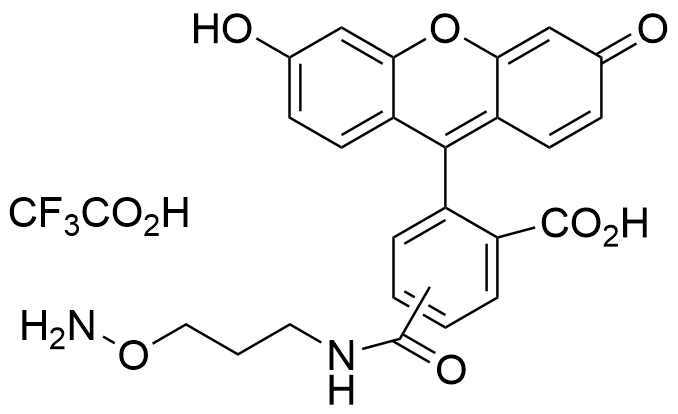Aminooxy-5(6)-FAM
Our aminooxy reagents such as aminooxy-5(6)-FAM react with aldehydes or ketones to form a stable oxime linkage under mild conditions, and can be used to label abasic sites in damaged DNA.
This product is available by special order only.
Please fill in the inquiry form and we will contact you shortly.
Please fill in the inquiry form and we will contact you shortly.
Wishlist updated! View wishlist
Product Description
Our aminooxy reagents such as aminooxy-5(6)-FAM react with aldehydes or ketones to form a stable oxime linkage under mild conditions. Similar to ARP (#90073), aminooxy-5(6)-FAM can be used to label abasic sites in damaged DNA. It can also be used to label polysaccharides and glycoproteins.
- λEx/λEm (pH 9) = 494/521 nm
- Orange solid soluble in DMF, DMSO, or pH >6.5 buffers
- Store at -20°C and protect from moisture and light
- C26H21F3N2O9
- MW: 562.5
You may also like…
CF® Dye & Biotin SE Protein Labeling Kits
Kits for succinimidyl ester labeling antibodies or other proteins with Biotium's next-generation CF® dyes or biotin. 3 x 1 mg labeling reactions per kit.
DMSO, Anhydrous
Anhydrous DMSO (dimethyl sulfoxide; methyl sulfoxide) is recommended for preparing stock solutions of AM ester dyes, reactive dyes and other related moisture-sensitive products.
Aniline, 10X in Acetate Buffer
Aniline, 10X in acetate buffer is designed to use as catalytic reagent for the optimal coupling of protein carbonyls with aminooxy compounds.
CF® Dye Aminooxy
CF® dyes with an aminooxy reactive group are useful for fluorescently labeling aldehyde or ketone groups on target molecules such as polysaccharides, glycoproteins or antibodies.
CF®DI Hydrazide
CF®DI dye hydrazides react with carbonyl moieties of aldehyde or ketone groups. They are size- and charge-matched for detection of protein carbonylation by fluorescence two-dimensional differential gel electrophoresis (2D-DIGE).
CF® Dye Hydrazide
Fluorescent CF® dye hydrazides are bright, extremely water-soluble, nontoxic molecules, useful as aldehyde-fixable cell tracers. They can also be used to label aldehyde or ketone groups of polysaccharides, carbohydrates or glycoproteins.

